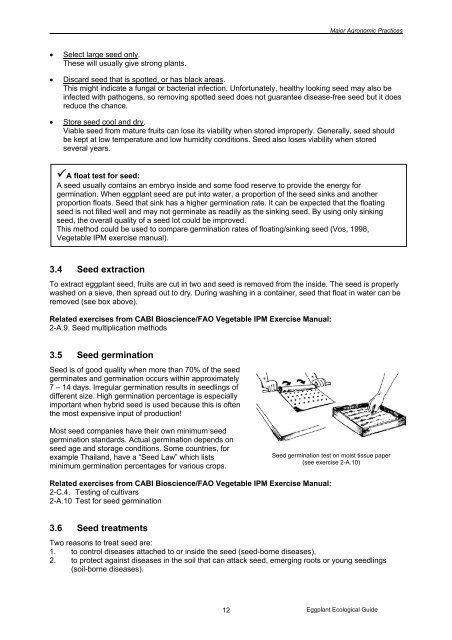Eggplant Integrated Pest Management AN ECOLOGICAL GUIDE
Eggplant Integrated Pest Management AN ECOLOGICAL GUIDE
Eggplant Integrated Pest Management AN ECOLOGICAL GUIDE
Create successful ePaper yourself
Turn your PDF publications into a flip-book with our unique Google optimized e-Paper software.
___________________________________________________________________________________Major Agronomic Practices• Select large seed only.These will usually give strong plants.• Discard seed that is spotted, or has black areas.This might indicate a fungal or bacterial infection. Unfortunately, healthy looking seed may also beinfected with pathogens, so removing spotted seed does not guarantee disease-free seed but it doesreduce the chance.• Store seed cool and dry.Viable seed from mature fruits can lose its viability when stored improperly. Generally, seed shouldbe kept at low temperature and low humidity conditions. Seed also loses viability when storedseveral years.A float test for seed:A seed usually contains an embryo inside and some food reserve to provide the energy forgermination. When eggplant seed are put into water, a proportion of the seed sinks and anotherproportion floats. Seed that sink has a higher germination rate. It can be expected that the floatingseed is not filled well and may not germinate as readily as the sinking seed. By using only sinkingseed, the overall quality of a seed lot could be improved.This method could be used to compare germination rates of floating/sinking seed (Vos, 1998,Vegetable IPM exercise manual).3.4 Seed extractionTo extract eggplant seed, fruits are cut in two and seed is removed from the inside. The seed is properlywashed on a sieve, then spread out to dry. During washing in a container, seed that float in water can beremoved (see box above).Related exercises from CABI Bioscience/FAO Vegetable IPM Exercise Manual:2-A.9. Seed multiplication methods3.5 Seed germinationSeed is of good quality when more than 70% of the seedgerminates and germination occurs within approximately7 – 14 days. Irregular germination results in seedlings ofdifferent size. High germination percentage is especiallyimportant when hybrid seed is used because this is oftenthe most expensive input of production!Most seed companies have their own minimum seedgermination standards. Actual germination depends onseed age and storage conditions. Some countries, forexample Thailand, have a “Seed Law” which listsminimum germination percentages for various crops.Seed germination test on moist tissue paper(see exercise 2-A.10)Related exercises from CABI Bioscience/FAO Vegetable IPM Exercise Manual:2-C.4. Testing of cultivars2-A.10 Test for seed germination3.6 Seed treatmentsTwo reasons to treat seed are:1. to control diseases attached to or inside the seed (seed-borne diseases),2. to protect against diseases in the soil that can attack seed, emerging roots or young seedlings(soil-borne diseases).12<strong>Eggplant</strong> Ecological Guide




![Section 4 [ PDF file, 252 KB] - The Field Alliance](https://img.yumpu.com/51387260/1/158x260/section-4-pdf-file-252-kb-the-field-alliance.jpg?quality=85)











